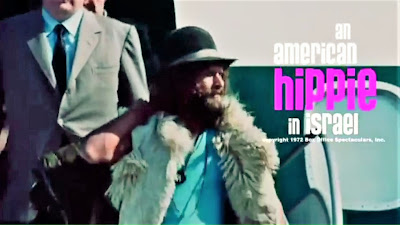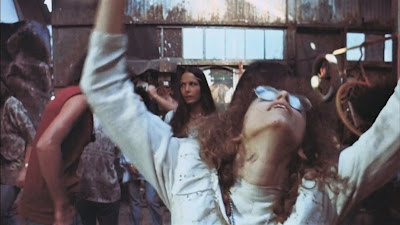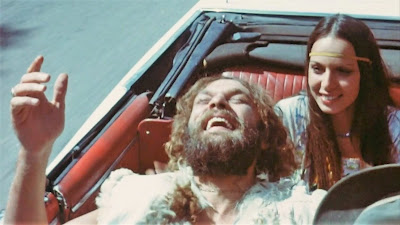"It's time to speak of unspoken things...."
Ad tagline for Joseph Losey's Secret Ceremony (1969)
Through the magic of special effects, films are ideally suited to
granting vivid, tangible realism to even the most fanciful narratives; thus, the representational side of ghost stories—such as materialized apparitions, floating objects, and the like—has always been well within the scope of where motion pictures excel. But too often, in the effort to deliver genuine scares, ghost story movies can rely too much on typical genre tricks, such as loud noises, jump cuts, gross-out imagery, exaggerating the ghost's powers, and the malevolence of their actions. All these standard suspense and horror devices are fine in and of themselves, but in the supernatural realm, they tend to turn ghost stories into little more than paranormal stalker thrillers.
Since what has always creeped me out the most about ghost stories is the mere "idea" of ghosts—that the dead retain a presence and consciousness of life—the literal depiction of phantasms onscreen isn't enough to elicit much of a response from me. In fact, when it comes to ghosts in films, my personal experience has been that the more overemphatic the visuals, the more muted their power to genuinely scare me.
When this occurs (as it frequently does in the thrillers of Hitchcock, Polanski, and Clouzot), I’m comfortable suspending my disbelief and surrendering to
the full arsenal of cinema’s storytelling vocabulary—music, cinematography,
performance, atmosphere, ambiguity, language—because it feels as though, in the formulating of the film as a whole, the director has already taken the active participation of the viewer into account.
 |
| "The Innocents" opened in Los Angeles on Friday, December 15, 1961 |
By this I mean that some films only work if both parties --filmmaker and audience-- hold up their end of the bargain. A good director will put everything onscreen that's necessary for a film to work, but will refuse to lay it in my lap and spell everything out. A smart film trusts an audience to be attentive and able to piece things together.
To me, this is the hallmark of any well-made film, but when speaking of horror and suspense, it's absolutely essential. One film that accomplishes all of the above spectacularly while also embodying the cinematic principle I call "the eloquence of ambiguity" is Jack Clayton's masterpiece, The Innocents.
 |
| Deborah Kerr as Miss Giddens |
 |
| Martin Stephens as Miles |
 |
| Pamela Franklin as Flora |
 |
| Megs Jenkins as Mrs. Grose |
 |
| Michael Redgrave as The Uncle |
William Archibald’s 1950 play The Innocents, adapted
from Henry James’ 1898 novella The
Turn of the Screw, serves as the
source for Jack Clayton’s decorously brooding 1961
film adaptation. This assured sophomore effort by the Oscar-nominated
director of Room at the Top (1959) boasts
a screenplay by Truman Capote and playwright/screenwriter
John Mortimer (Bunny Lake is Missing). The latter contributing a few scenes and adding a touch of Victorian verisimilitude to the dialogue.
Indeed, the film's Victorian setting, with its emphasis on persistent propriety and the appearance of order at all costs, is every bit a character in this ghost story, as is the pervading presence of the tale's no-longer-living lovers. It’s a ghost story best whispered, a dark poem about past lives lingering, and a solemn tale befitting the somber corners and shadowy hallways of a gothic mansion.
The Innocents stars Deborah Kerr as Miss Giddens, a naïvely pious governess dispatched to care for two children at a remote British country estate. A large, desolate space she comes to fear is haunted by the ghosts of her predecessor (Miss Jessel) and a valet of bestial repute named Peter Quint. The illicit lovers both died under mysterious circumstances on the estate not long before, yet it appears to be their wish that their presence remain felt in the lives of its present inhabitants. Their spiritual presence is fearful enough, but compounding Miss Giddens' dread is the mounting certainty that the nature and intent of the haunting is the moral corruption of the two children left in her charge: angelic, guilelessly morbid Flora (Franklin), and charming, disturbingly mature Miles (Stephens).
The Innocents stars Deborah Kerr as Miss Giddens, a naïvely pious governess dispatched to care for two children at a remote British country estate. A large, desolate space she comes to fear is haunted by the ghosts of her predecessor (Miss Jessel) and a valet of bestial repute named Peter Quint. The illicit lovers both died under mysterious circumstances on the estate not long before, yet it appears to be their wish that their presence remain felt in the lives of its present inhabitants. Their spiritual presence is fearful enough, but compounding Miss Giddens' dread is the mounting certainty that the nature and intent of the haunting is the moral corruption of the two children left in her charge: angelic, guilelessly morbid Flora (Franklin), and charming, disturbingly mature Miles (Stephens).
The film’s slowly intensifying disquietude—the narrative turn of the
screw—arises from both uncertainty and ambiguity. There's uncertainty as to whether the children are truly the innocents they appear to be, or if, in fact, they are wily co-conspirators in league with the phantoms. The ambiguity relates to the possibility that the spectral
terrors befalling Bly House are not real at all, but merely figments of Miss Giddens’ imagination; the fevered manifestations of an emotionally repressed mind.
More than just a faithful adaptation of a literary classic, The Innocents is a suitably atmospheric elucidation of the novella's themes. Taking great pains to
distance itself from the full-color, purple gothic of the then-popular Hammer series
of horror films, this British production has pedigree and craftsmanship oozing like ectoplasm from every frame.
Filmed in glorious black and white, which grows increasingly starker as the film progresses,
Filmed in glorious black and white, which grows increasingly starker as the film progresses,
the cinematographer is two-time Oscar winner Freddie Francis
(who has the dubious distinction of being the director of Trog, Joan Crawford's last film, and a horror of a different stripe). Atypically for the genre, The Innocents is shot in widescreen Cinemascope: a
20th Century-Fox prerequisite for its “A” productions at the time.
From Jack Clayton’s perceptive direction to the affecting
performances of its talented cast, everything about The Innocents: location, décor, and especially its use of sound and
the innovative integration of electronic synth to its music score--has been
done to capture the feel of James’ novel and remain true to its subtle horror.
 |
| Clytie Jessop as Miss Jessel |
WHAT I LOVE ABOUT THIS FILM
The Innocents is a film I discovered somewhat late in the game, watching it for the first time only a few years ago after several friends recommended it once they learned about my newfound appreciation for Deborah Kerr. I was told it was both one of Kerr's best films and her personal favorite of all her performances.
I have a vague recollection of seeing part of The Innocents when I was a kid; a memory wedded in my mind with seeing The Haunting on TV (a
film I now see owes quite a lot to Jack Clayton) and concluding in both cases that, to my then Creature Features-weaned mind, the movies weren't scary enough to hold my interest because “nothing happens.”
 |
| Peter Wyngarde as Peter Quint |
I can’t remember when I’ve seen a more beautifully
shot horror film (the edges of the frames are blurred, giving the impression of
things hidden and lurking in corners), nor one with a screenplay so richly detailed in character and a sense of time and place. But the real trick up The Innocents’ sleeve is its narrative ambiguity. It’s extremely skilled
in establishing Bly House as a place of strange goings on, of encroaching
decadence and decay, but just as deftly, it hints that the principled, impressionable
Miss Giddens might be something less than a reliable narrator.
The puzzle of the story is compellingly provocative, and the whole film is shrouded in a disturbing sense of discordant interactions. But what cemented The Innocents as an enduring favorite (and made watching the film a genuinely frightening experience, one I was more than happy to repeat) is how its ambiguous structure played with my imagination just as deftly as the shadows and barely heard whispers in Bly House played with those of Miss Giddens.
 |
| Are the others unable to see, unwilling to see, or is there simply nothing there to be seen? |
The puzzle of the story is compellingly provocative, and the whole film is shrouded in a disturbing sense of discordant interactions. But what cemented The Innocents as an enduring favorite (and made watching the film a genuinely frightening experience, one I was more than happy to repeat) is how its ambiguous structure played with my imagination just as deftly as the shadows and barely heard whispers in Bly House played with those of Miss Giddens.
PERFORMANCES
My youthful antipathy toward the work of Deborah
Kerr really kept me from many films I know I would have enjoyed immensely during my adolescence. This gross discrediting of the immensely talented actress is rooted in my first having
become aware of her work through a series of late-career head-scratchers that hardly
did her justice. It did me no favors to be introduced to Deborah Kerr via the films Prudence and the Pill,
Casino Royale, and Marriage on the Rocks. They may have been movies she enjoyed making, but to me, they established her as a charming but starchy British actress drawn to moldy sex comedies, and I thereafter avoided anything with her name attached to it. Bonjour Tristesse is the film that turned me around, followed by the glorious Black Narcissus, and now The Innocents—unequivocally my favorite performance by Deborah Kerr. In fact, I consider it to be one of the most extraordinary screen performances I've ever had the good fortune to come across.
Given how
often I’ve watched The Innocents merely
to see the play of emotions across Deborah Kerr’s face—some of the most complex
appearing in almost imperceptibly brief flashes of brilliance—I, like Kerr herself, am convinced
this film is her finest screen performance. With the entire film hinging upon the arc of Miss Giddens’ character from empathetic voice of reason to irrational, possibly unstable fantasist, Kerr moors this ghost story in a gripping emotional realism.
With no dialogue specifically addressing the source of her character’s many “issues” (the fervency of her devotion to children, the cause of her troubled dreams, the austerity of her existence, her sexual repression/preoccupation) she makes The Innocents as much a film about the dangers of repressed desire cloaked in moral rectitude as it is about the corruption of innocence.
With no dialogue specifically addressing the source of her character’s many “issues” (the fervency of her devotion to children, the cause of her troubled dreams, the austerity of her existence, her sexual repression/preoccupation) she makes The Innocents as much a film about the dangers of repressed desire cloaked in moral rectitude as it is about the corruption of innocence.
Deborah
Kerr makes the movie for me, but the two child actors portraying Miles and
Flora are beyond impressive. Both Pamela Franklin (the wondrous actress from Our Mother's House and The Prime of Miss Jean Brodie making her
film debut) and near-veteran Martin Stephens (Village of the Damned) credit their performances with the patience bestowed
by Jack Clayton, but I think that’s only partially the case. These kids bring
an incredible amount of creepy purity to their roles.
Kids in
horror movies are meant to ratchet up the jeopardy-factor, but too often the reality is, in the
casting, that they tend to be a pretty vacuous addition; vortices
of irritation, sucking the energy out of perfectly good horror films. For the
radiance of every Patty McCormack in The Bad Seed there are countless half-pint deadweights like the twin blank slates cast in The Other (1972); that
annoying brat in Burnt Offerings (1976); the dyspeptic son-of-a-devil in the 2001 remake of The Omen; and worst-offender prize-winner, the noxious child in the
TV movie version of The Shining, who
had viewers praying for his REDRUM.
Compare
the knowing and disturbing performances of Flora and Miles in The Innocents (Stephens managing to be
also heartbreakingly touching) with their elongated, vacant-eyed counterparts
in The Nightcomers, and you get
a true sense of the enormous contribution Franklin Stephens' and Pamela Franklin's canny knowingness makes to the overall
chilly effectiveness of The Innocents.
THE STUFF OF DREAMS  |
| Purity Devoured by Evil |
A testament to the richness of The Innocents’ ambitiously ambiguous structure is that its themes
of innocence defiled and wholesomeness decayed extend to the enigmatic efficiency of
its title.
Who are "the innocents"?
Taken literally, it refers most obviously to Miles &
Flora, children whose innocence Miss Giddens fears has been robbed of them due
to their exposure to the “indecencies” of Quint and Miss Jessel’s relationship. And, taking this tack, most certainly the sheltered Miss Giddens also qualifies as an innocent, not only due to her novice status as a governess but also born of her naiveté and misguided moral indomitability in the face of an evil she can scarcely comprehend. Even Miss Grose, with her determined refusal to entertain even the
dimmest thought of anything untoward, represents innocence preserved through obliviousness.
 |
| Purity Decayed A bug crawls out of the mouth of a garden cherub |
I personally gravitate to a literal interpretation of the film’s title, but equally persuasive is the theory that The Innocents is meant paradoxically, like the ironic titles of Edith Wharton novels: The Age of Innocence and The House of Mirth. From this perspective, The Innocents could allude to the Christian concept of original sin and how all acquired knowledge—carnal or otherwise—is essentially innocence lost. From the perspective that even the mere awareness of or exposure to evil represents a form of spiritual corruption, no one in the film qualifies as an innocent.
The self-interested uncle feigns no innocence, although his failure to fully disclose to Miss Giddens what truly transpired between Quint and Miss Jessel in his country home can be interpreted as a pretense of innocence to avoid losing her as a potential governess.
Miss Giddens’ innocence is called into question when one
considers how her reaction to the uncle (obvious infatuation) is mirrored in
her response to first meeting Miles. It has been suggested that her fervent
devotion to children and lack of interests outside of their welfare masks a
repressed, embattled sexuality. Like many an overzealous “family values” politician, Miss Giddens is a mass of closeted desires and is unwholesomely obsessed with obscenity.
Mrs. Grose, the only adult in a position to be fully aware of what risk to the children Quint and Miss Jessel posed, nevertheless prefers to shun imagination, close her eyes in the dark, and meet everything she doesn’t understand with a dismissive "Stuff and nonsense.” A willful ignorance and a means of shrouding herself in false, "blameless" innocence.
Mrs. Grose, the only adult in a position to be fully aware of what risk to the children Quint and Miss Jessel posed, nevertheless prefers to shun imagination, close her eyes in the dark, and meet everything she doesn’t understand with a dismissive "Stuff and nonsense.” A willful ignorance and a means of shrouding herself in false, "blameless" innocence.
The question posed by the superficially benign behavior of the children is the one Miss Giddens asks herself: are they truly
oblivious to the hauntings and all they have been exposed to, or do they merely
pretend? Although we hate to admit it, children have a natural sexual curiosity devoid of an awareness of morality. When we insist on imposing moral imperatives, telling them such thoughts are wicked and wrong, it's not difficult to view such well-meaning "protective" behavior - introducing children to the concept of evil - as a corruption of their natural innocence.
THE STUFF OF FANTASY
Owing to my having more practical, real-life experience with
familial dysfunction than either ghosts or haunted houses, I like horror films that make
a case for supernatural disturbances arising from emotional and psychological crises. When I think of my favorite horror movies: Rosemary’s Baby, Burnt Offerings, The Shining, The Stepford Wives, The Omen,
The Exorcist, and The Haunting--they all start with
characters whose relationships and/or emotional states are already shown to be under some considerable stress.
Early on in The
Innocents, it’s hinted that the very qualities characterizing Giddens as a
suitable governess—single (and perhaps given to flights of romantic fantasy, “You do look pleased!” remarks Flora,
noticing Miss Giddens’ reaction to receiving a letter from the handsome uncle),
sensitive, morally devout, a strong love of children—are the very aspects of her
personality which will later prove to be where she is most vulnerable.
The positive, sensual overstimulation she feels with her
arrival at the manor (whose every corner of tranquil beauty also reveals an air of
decay) turns feverish and detrimental only in proportion to what she learns
about the children’s past and their relationship with Quint and Miss Jessel. As The Innocents reveals itself to be a
ghost story, it also exposes its roots in Victorian repression; for one gets
the distinct impression that for Miss Giddens, the materialization of the
ghosts themselves is a horror, but one secondary to the real “evil” they
represent: sex.
Clip from "The Innocents" (1961)
Insights: The Making of "The Innocents" (2006) Click HERE to watch the 30 min. documentary
 |
| Director Jack Clayton and Pamela Franklin behind the scenes during the filming of The Innocents |
This speculative take on the events preceding The Innocents is vastly inferior and literal-minded, but as a curiosity (Marlon Brando's accent!), it's worth a look.
 |
| "More than anything, I love children. More than anything." |
Copyright © Ken Anderson 2009 - 2017









































